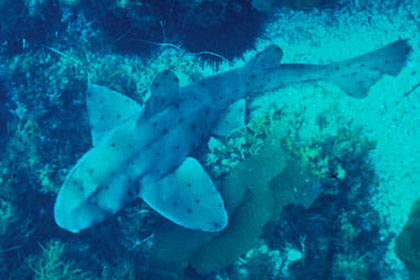Back in my early days of diving, a couple of men I knew sported necklaces featuring a single horn shark spine. Luckily, the days of West Coast divers killing harmless sharks for jewelry didn’t last long.
Horn sharks (Heterodontus francisci) are members of the order Heterodontiformes (bullhead sharks) and the family Heterodontidae. The genus name, Heterodontus, comes from two Greek words meaning “different teeth” and the species name, francisci, is derived from San Francisco, though these sharks rarely venture that far north.
Heterodontidae is a small family with one genus and eight species. The only one found in SoCal waters is the horn shark. Horn sharks have a piglike snout, ridges above their eyes, a small mouth, rough skin and broad, rounded pectoral fins. There is a spine on the leading edge of each of the two dorsal fins. They also have anal fins, nasal flaps, five gill slits and a small spiracle behind and below each eye. The sharks are brown or tan and have black spots, which vary in number from animal to animal.
The first shark I photographed was a juvenile Heterodontus francisci. Horn sharks are nonaggressive bottom dwellers. They are nocturnal and don’t like to move around during the day. That explains why I was able to get close-up photographs of pertinent parts such as the spines (also called horns), the fascinating eye, the skin and the unusual mouth and teeth. Then I moved on and the shark, if it had ever awakened, went back to sleep.
True to their genus name, horn sharks have two kinds of tiny grinding teeth. Those in the front of the mouth are pointed, those near the back, jagged and blunt. They are ideal for eating crustaceans, mollusks, sea urchins and small fishes. Dr. Milton Love says they are also known to “enter tide pools to feed on green sea anemones.” Northern elephant seals eat horn shark adults, juveniles and their eggs. Also, they are eaten by bald eagles at Catalina Island, and large marine snails drill into their egg cases to eat the yolk.
From afar, shark skin looks smooth and sleek but up close you can see it is composed of tiny scales called denticles. Similar to teeth in structure, denticles have a hard outer layer of enamel.
The horn shark’s two nostrils are found on the underside of its mouth and bear a vague resemblance to a ram’s horn. Jeffrey Rotman, writing in Shark! says these “convoluted nostrils … enable it to detect microscopic levels of chemicals in the water.”
Horn sharks mate during the winter months. The male grasps one of the female’s pectoral fins in his mouth and inserts one of his two claspers in her cloaca, and settles in for a while; the transfer of sperm typically takes 30 to 40 minutes.
All bullhead sharks lay auger-shaped egg cases called “mermaids’ purses.” The horn shark’s eggs are laid between January and April. The females are finicky about where their unusual looking eggs end up. They are known to pick the eggs up in their mouths and stash them in more suitable places, where the shape and whorls of the cases make extracting them difficult. A female will lay 10 to 16 egg cases (often two at a time) over a period of several weeks. Sources vary as to whether the eggs hatch in 8 to 10 weeks or 7 to 9 months. In any case, the five-inch long babies that emerge are miniature versions of their parents.
Horn sharks can reach lengths of four feet and weigh as much as 20 pounds. They are found from intertidal waters down to 656 feet and range from Central California to the Gulf of California and perhaps as far as Ecuador and Peru. I have had the best luck seeing horn sharks off the islands of Catalina (front and back sides) and San Clemente. They were always in shallow water close to shore.
The author wishes to thank Dr. Milton Love for his help in the preparation of this article. Dr. Love is the author of Certainly More than You Want to Know About Fishes of the Pacific Coast.
Horn Shark Facts
Kingdom: Animalia
Phylum: Chordata
Subphylum: Vertebrata
Superclass: Gnathostomata
Superclass: Pisces
Order: Heterodontiformes
Family: Heterodontidae
Genus: Heterodontus
Species: francisco










